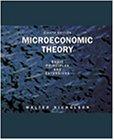3.8 Example 3.3 shows that the MRS for the Cobb-Douglas function U(X, Y) = X aY^ is...
Question:
3.8 Example 3.3 shows that the MRS for the Cobb-Douglas function U(X, Y) = X aY^
is given by MRS= ^(Y/X).
P
a. Does this result depend on whether a + (3 = 1? Does this sum have any relevance to the theory of choice?
b. For commodity bundles for which Y = X, how does the MRS depend on the values of a and /3? Develop an intuitive explanation of why if a > (3, MRS > 1. Illustrate your ar gument with a graph.
Fantastic news! We've Found the answer you've been seeking!
Step by Step Answer:
Related Book For 

Microeconomic Theory Basic Principles And Extensions
ISBN: 9780030335938
8th Edition
Authors: Walter Nicholson
Question Posted:






